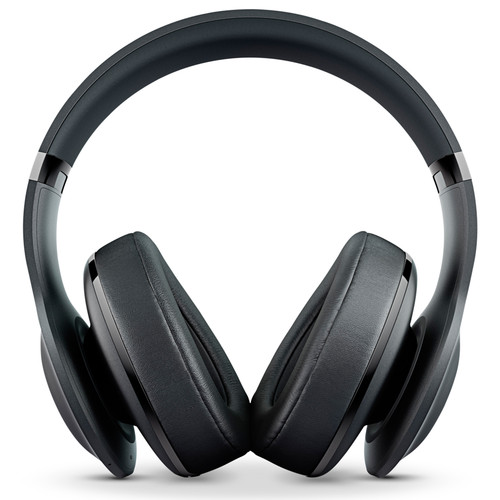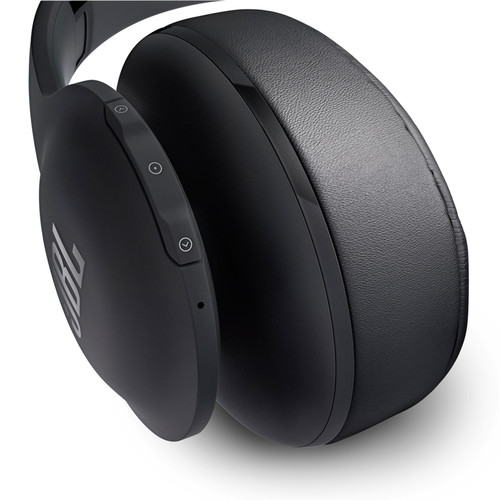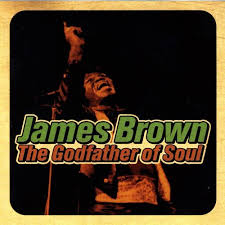JBL Everest 700 Headphones

 The marketplace for Bluetooth over-ear (and on-ear) headphones is crowded. The JBL Everest 700 ($199.95, jbl.com) is in the same league as fashionable ‘phones such as the Monster Clarity ($149.95, monsterproducts.com), the Skull Candy Crusher ($199.99, skullcandy.com), and the Beats by Dre Solo 3 Wireless ($299.95, beatsbydre.com). They are not neutral sounding, audiophile headsets such as the Sennheiser D 4.40 BT ($149.95), the Bowers & Wilkins P5 Wireless and P7 Wireless ($299.99 and $399.99, respectively, bowers-wilkins.com), or the AKG K 845BT ($299.95, akg.com) but do not make that claim either. Hi-res fans or those that only listen to FLAC may be more interested in the latter group of audiophile products. The JBL is quite satisfactory for everyday listening on YouTube, Spotify and other streaming services but are not the most sonically advanced when compared to many other Bluetooth headphones that are available.
The marketplace for Bluetooth over-ear (and on-ear) headphones is crowded. The JBL Everest 700 ($199.95, jbl.com) is in the same league as fashionable ‘phones such as the Monster Clarity ($149.95, monsterproducts.com), the Skull Candy Crusher ($199.99, skullcandy.com), and the Beats by Dre Solo 3 Wireless ($299.95, beatsbydre.com). They are not neutral sounding, audiophile headsets such as the Sennheiser D 4.40 BT ($149.95), the Bowers & Wilkins P5 Wireless and P7 Wireless ($299.99 and $399.99, respectively, bowers-wilkins.com), or the AKG K 845BT ($299.95, akg.com) but do not make that claim either. Hi-res fans or those that only listen to FLAC may be more interested in the latter group of audiophile products. The JBL is quite satisfactory for everyday listening on YouTube, Spotify and other streaming services but are not the most sonically advanced when compared to many other Bluetooth headphones that are available.


Even before putting them up to my ears, the Everest 700 headphones impress with their well-designed and sturdy packaging. They arrive in a white and orange shell, which encases a firm inner box. The inner box displays a rave scene on the front panel, and opens to reveal the headphones and accessories. The headphones themselves are secured firmly within the box, and underneath them are the USB charger, headphone cable, and user guides. The Everest 700 headphones are a simple and clean design. The JBL logo is displayed on the outside of both ear cups, and the stereo indicators are displayed inside the ear cups on the black filters. The ear cups themselves are made from grey leather and provide a high degree of noise isolation, simply from their comfortable seal. Elegant buttons found next to the left and right ear cups control the headphone functions, as well as charging and USB ports. In terms of fit and feel, the headphones hold their position well and can be adjusted by sliding metal bands. It is worth mentioning here though, that although the ear cups provide lasting comfort, the design of the headband has some problems. Both the flatness at which the headband hits the head, and its minimal padding, lead to some discomfort even during short listening sessions.

The setup of the Bluetooth system is incredibly easy. Simply turn on the headphones by holding down the power button, and a voice will come through the headphones, saying that the pairing mode is enabled. From there, you simply pair the headphones with your Bluetooth enabled device. The Bluetooth system worked flawlessly every time I tried it, but it is worth mentioning that when I watched videos over Bluetooth, there was a significant enough delay to make it pretty annoying. This is not an issue when listening to music by itself, but something to note if you plan to do a lot of video watching.
 In terms of reviewing sound quality, I started out my listening session with some James Brown, beginning with the song, Gonna Have a Funky Good Time. Most of James Brown’s music is rooted in a particular kind of groove, known as funk. Groove is about rhythm and pulse, and both of those musical elements require clarity. Thus, I was particularly curious how the JBL headphones would perform in the context of funk. Some over ear-headphones that seal, act as resonance chambers. This is great for quality of sound, but not so great for crispness and clarity. With the JBL however, despite their respectable seal, they were crisp and clear, and not at all overly boomy. I was able to hear the articulation of James Brown’s spoken moments, which mirror the staccato articulations of the plucked instruments. His raspy singing voice, came through very distinctly and contrasted well with the quickly decaying guitars. I was also particularly impressed with the sense of space of the soundstage that these headphones produced. Between the instrumentalists, back-up singers, and James Brown on lead, there is a lot going on, yet I really felt like I heard each of these musical sections being in discreet places. This helped to bring out the overall clarity as well. In the context of James Brown, the headphones do seem to favor the upper register, and because this song is heavy on the plucked instruments, the electric guitar pops out of the texture most. It’s worth noting here that especially with funk, I do wish these headphones had delivered a more full-bodied bass guitar sound, since that’s the instrument that gives the essential feel of the groove.
In terms of reviewing sound quality, I started out my listening session with some James Brown, beginning with the song, Gonna Have a Funky Good Time. Most of James Brown’s music is rooted in a particular kind of groove, known as funk. Groove is about rhythm and pulse, and both of those musical elements require clarity. Thus, I was particularly curious how the JBL headphones would perform in the context of funk. Some over ear-headphones that seal, act as resonance chambers. This is great for quality of sound, but not so great for crispness and clarity. With the JBL however, despite their respectable seal, they were crisp and clear, and not at all overly boomy. I was able to hear the articulation of James Brown’s spoken moments, which mirror the staccato articulations of the plucked instruments. His raspy singing voice, came through very distinctly and contrasted well with the quickly decaying guitars. I was also particularly impressed with the sense of space of the soundstage that these headphones produced. Between the instrumentalists, back-up singers, and James Brown on lead, there is a lot going on, yet I really felt like I heard each of these musical sections being in discreet places. This helped to bring out the overall clarity as well. In the context of James Brown, the headphones do seem to favor the upper register, and because this song is heavy on the plucked instruments, the electric guitar pops out of the texture most. It’s worth noting here that especially with funk, I do wish these headphones had delivered a more full-bodied bass guitar sound, since that’s the instrument that gives the essential feel of the groove.
I Got the Feelin’ was up next. In this song, the brass section and drum kit are the backbone of the groove. The use of low brass instruments augments the bass guitar, bringing out the lower register here better, but still, I wanted more bottom end from the funk groove. Despite that, there was good clarity in all registers, and the balance between solos and backup were excellent. Try Me is written in a more soulful, lyrical style. On this song, the JBL headphones brought out again a nicely balanced sense of space, giving the instrumentalists, backup singers, and James Brown their own locations on the soundstage. The blend too, was absolutely perfect.
 Next, I listened to Yehudi Menuhin’s 1962 recording of Beethoven’s Violin Concerto. I was particularly curious to hear this piece through the JBL headphones because in the first movement, the timpani’s heartbeat is an essential motivic element, and I wanted to hear how this register came through in the context of classical music. I was delighted when I heard that the timpani gestures were in no way muted or muffled in this context, but rather sounded full and resonant. In fact, sometimes distinguishing the changes of pitch in the timpani can be difficult in general, but here, the JBL audibly brought them out. What I also noticed right away was the intimacy of sound that the headphones gave to the solo violin. When the violin finally comes in after the extended orchestral opening, I could hear little nuances of shifts and vibrato, and the textured quality of the violin’s tone, as if it were under my ear. All of this added up to a very intimate and personable performance, something for which Yehudi Menuhin is often lauded. When it came to the cadenza near the end of the first movement, I was completely wowed by the performance of the headphones. The fury of the cadenza, written by Fritz Kreisler, truly puts in relief the pureness of Beethoven’s motivic treatment up to this point. It really takes Beethoven’s ideas off the rails, in a gritty, gripping, and virtuosic way. Menuhin expresses this to its fullest potential in a way that we rarely hear from modern performers today, and these headphones caught every moment of it. In fact, throughout the entire first movement, the JBL 700 headphones highlighted Menuhin’s expansive expressiveness, from the vulnerable, to the despairing, to the heroic.
Next, I listened to Yehudi Menuhin’s 1962 recording of Beethoven’s Violin Concerto. I was particularly curious to hear this piece through the JBL headphones because in the first movement, the timpani’s heartbeat is an essential motivic element, and I wanted to hear how this register came through in the context of classical music. I was delighted when I heard that the timpani gestures were in no way muted or muffled in this context, but rather sounded full and resonant. In fact, sometimes distinguishing the changes of pitch in the timpani can be difficult in general, but here, the JBL audibly brought them out. What I also noticed right away was the intimacy of sound that the headphones gave to the solo violin. When the violin finally comes in after the extended orchestral opening, I could hear little nuances of shifts and vibrato, and the textured quality of the violin’s tone, as if it were under my ear. All of this added up to a very intimate and personable performance, something for which Yehudi Menuhin is often lauded. When it came to the cadenza near the end of the first movement, I was completely wowed by the performance of the headphones. The fury of the cadenza, written by Fritz Kreisler, truly puts in relief the pureness of Beethoven’s motivic treatment up to this point. It really takes Beethoven’s ideas off the rails, in a gritty, gripping, and virtuosic way. Menuhin expresses this to its fullest potential in a way that we rarely hear from modern performers today, and these headphones caught every moment of it. In fact, throughout the entire first movement, the JBL 700 headphones highlighted Menuhin’s expansive expressiveness, from the vulnerable, to the despairing, to the heroic.
Overall, I can recommend the JBL Everest 700 headphones to anybody wanting a high quality Bluetooth musical experience. With the caveat that the delay may be a hindrance to some, these headphones would be perfect for use at the gym, or doing work around the house. I doubt there is better audio quality out there for the very reasonable price at which these headphones run. These are a solid find. 

mark abell
PRODUCT HIGHLIGHTS
Price: $199.00
40mm Drivers
10 Hz to 22 kHz Frequency Response
Bluetooth 4.1 Wireless Connectivity
JBL ShareMe 2.0
Up to 25-Hour Battery Life
Built-In Microphone
Includes Micro-USB Charging Cable
Includes 3.5mm Audio Cable
Website: www.JBL.com
Stereo Times Masthead
Publisher/Founder
Clement Perry
Editor
Dave Thomas
Senior Editors
Frank Alles, Mike Girardi, Key Kim, Russell Lichter, Terry London, Moreno Mitchell, Paul Szabady, Bill Wells, Mike Wright, Stephen Yan, and Rob Dockery
Current Contributors
David Abramson, Tim Barrall, Dave Allison, Ron Cook, Lewis Dardick, Dan Secula, Don Shaulis, Greg Simmons, Eric Teh, Greg Voth, Richard Willie, Ed Van Winkle, and Rob Dockery
Music Reviewers:
Carlos Sanchez, John Jonczyk, John Sprung and Russell Lichter
Site Management Clement Perry
Ad Designer: Martin Perry





Be the first to comment on: JBL Everest 700 Headphones